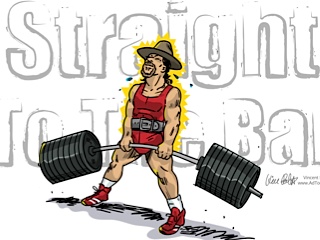
Wrist strength is very important for many sports, especially those that include the use of bats, sticks, rackets, and other implements. If the wrists are weak, the athlete will not be able to project full force with the implement of his or her sport, and will not have 100% control. Weak wrists in baseball could cause the batter to not be able to check the swing when he realizes the pitch is a ball.
Wrist strength is also very important for keeping the wrist joint healthy. In contact sports, injuries of the wrist are all too common and they can be very nagging on the field or court. These injuries can take a very long time to heal, keeping the athlete out of the game for weeks at times. Strong wrists are more resilient against injury, so athletes must properly prepare them for competition forces.
Unfortunately, many sports teams are not strengthening their wrists properly. Often, sports teams’ main grip, forearm, and wrist training is built around one single movement: Wrist Curls. While wrist curls are great for a pump, they do very little for the important sports-specific properties already established at the beginning of this article – force generation, bat/stick/racket control, and injury prevention.


Proper wrist training should be done through all angles, encompassing the many different functions of the wrist including flexion, extension, and ulnar and radial deviation. The images at the left show these four basic movements of the wrist, and in order to prepare for competition, time in the weight room should be dedicated to strengthening all of them. It is plain to see that wrist curls are not going to cut in order to strengthen the wrist in the many angles of movement in which it is designed to perform. So the challenge is before us to find a suitable way to train the wrists.
The sledge hammer is a starting point. An 8-lb sledge hammer costs roughly $25, so it is not an expensive piece of equipment by any means, making it a painless addition to your training collection. The sledge hammer can be used to train the wrist in flexion, extension, and ulnar and radial deviation in a multitude of different ways. What follows is a series of simple exercises you can start off with, using the sledgehammer.
Vertical Lever to the Nose
The first exercise is the Vertical Lever to the Nose. The hammer is brought to the vertical position, lowered under control to the nose or head, and then returned to the vertical position. This exercise trains ulnar deviation.


Possible variations:
- – Perform the exercise for reps at normal speed
– Perform the exercise for reps while moving the hammer slowly during the eccentric portion of the exercise
– Hold the hammer at the lowered position prior to returning the hammer to the upright position
– Adjust the grip up and down the handle to increase or decrease intensity, remove a finger or two to increase the crushing / dynamic support component of the fingers.
Horizontal Lever to the Front
The next exercise is the Horizontal Lever to the Front. Begin with the hammer at your side, with the head pointed downward. Lever the hammer upwards until the hammer handle is horizontal or higher. This exercise works radial deviation.


Possible variations:
- – Hold the hammer at the top in the horizontal position for time with a coin on the head of the hammer without letting the coin slide off
– Bring the hammer to the horizontal position, then let go of your grasp and try to catch the hammer before it hits the ground
– Toss the hammer from one hand to another without dropping the hammer or lowering the head to the ground.
Hammer Twist
The next exercise is hammer twists. This lift will accomplish both flexion and extension of the wrist. Grasping the hammer near the middle of the handle, perform wrist flexion and extension. With the hammer head pointing forward, there will also be emphasis on developing strength in the radial deviators of the wrist, as they act to counterbalance of the leverage of the hammer, trying to pry the wrist into ulnar deviation.


Possible variations:
- – Turn the hammer around so the head points backwards in order to add the ulnar deviation component
– Move away from the center of the hammer to increase the challenge toward ulnar or radial deviation, unwrap the thumb from the grasp in order to force the fingers to work harder
– Open the hand and allow the hammer to travel closer to the finger and thumb tips, engaging more of a pinch grip on the handle and increasing the challenge in flexion and extension.
As you can see, hammer training is very versatile. There are practically endless variations in the way you can train with them. By applying simple and subtle changes to the way one performs the exercises, the place or way the handle is gripped, or by applying chaos by tossing or releasing the hammer, the wrists will soon become bulletproof.
These exercises and many more appear in the Nail Bending eBook. The sledgehammer has been used by many to increase wrist strength for bending nails, bolts, and steel. It will also prove useful for increasing wrist power in sport, and durability of the joint for heavy contact activities. Click here to check out the Nail Bending eBook and discover many other exercises for building tremendous wrist and lower arm strength.
Jedd










0 Comments